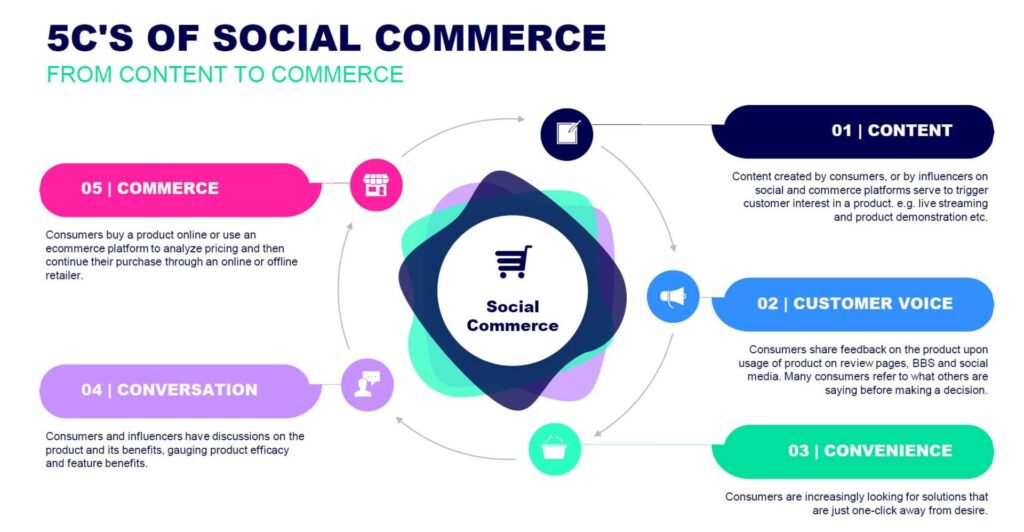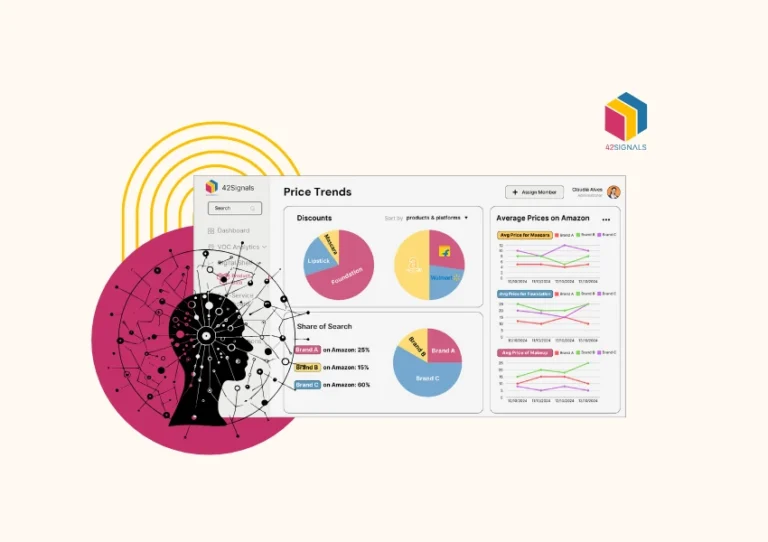Social commerce, the blend of social media and e-commerce, has emerged as a powerful force, transforming traditional marketing strategies and reshaping the consumer experience.
Let’s look at the rise of online commerce, exploring how it’s redefining customer connections, the benefits it offers, and the challenges it presents to brands navigating this dynamic landscape.
The Evolution of Social Commerce
Social commerce isn’t a new concept, but its rapid growth in recent years has been nothing short of revolutionary. Initially, social media platforms served as a space for brands to build awareness and engage with audiences. Over time, these platforms evolved into bustling marketplaces where products could be discovered, reviewed, and purchased—all within a few clicks.

Image Source: Wfanet
The integration of shopping features directly into social media platforms has blurred the lines between browsing and buying. Instagram’s Shoppable Posts, Facebook Marketplace, Pinterest’s Buyable Pins, and TikTok’s in-app shopping features are prime examples of how social media has transformed into a hub for both inspiration and instant purchases. Consumers no longer need to leave their favorite platforms to make a purchase; instead, they can seamlessly transition from discovery to checkout, enhancing convenience and satisfaction.
Redefining Customer Connections
The rise of social commerce has fundamentally changed the way brands connect with customers. Unlike traditional e-commerce, which often relies on search-driven traffic and direct website visits, digital commerce thrives on discovery and social interaction. This shift has created a more personalized, engaging, and community-driven shopping experience.

Image Source: Hubspot
1. Personalization and Targeting
Social media platforms are treasure troves of data, enabling brands to understand consumer behavior, preferences, and trends like never before. This wealth of information allows brands to tailor their offerings, creating highly personalized shopping experiences. By leveraging algorithms and AI, brands can present products that align with individual interests, increasing the likelihood of conversion. This level of personalization makes customers feel seen and understood, fostering stronger connections.
2. Influencer Partnerships
The role of influencers in social commerce cannot be overstated. Influencers bridge the gap between brands and consumers, adding authenticity and trust to the purchasing process. Whether through product reviews, unboxings, or styling tips, influencers help to humanize brands, making them more relatable. This connection is invaluable, as consumers are more likely to purchase products recommended by someone they follow and trust.
3. Real-Time Interaction
Social media commerce allows for real-time engagement between brands and customers. Features like live shopping events, Q&A sessions, and direct messaging provide immediate customer service and support. This level of interaction not only enhances the shopping experience but also builds brand loyalty. Customers appreciate the instant gratification of getting their questions answered and the ability to make informed decisions quickly.
4. Community Building
Digital commerce is not just about selling products; it’s about building communities around brands with great product experiences. By fostering conversations and encouraging user-generated content, brands can create a sense of belonging among their customers. Hashtags, challenges, and collaborative campaigns invite consumers to participate in brand narratives, making them feel like an integral part of the brand’s journey. This community-driven approach strengthens brand loyalty and turns customers into advocates.
The Benefits of Social Commerce for Brands
The integration of social media commerce into marketing strategies offers a myriad of benefits for brands, ranging from increased visibility to enhanced customer relationships.

Image Source: Gorgias
1. Increased Reach and Visibility
Social media platforms have billions of active users worldwide, offering brands an unparalleled reach. By leveraging digital commerce, brands can tap into new audiences that may not have discovered them through traditional e-commerce channels. The viral nature of social media also means that a single post or campaign can rapidly gain traction, significantly boosting brand visibility.
2. Higher Conversion Rates
It simplifies the buying process, reducing friction and improving conversion rates. When customers can purchase products directly within the platform they’re using, there’s less chance of them abandoning their cart. Additionally, the integration of reviews, ratings, and recommendations within social media platforms builds trust, making consumers more confident in their purchase decisions.
3. Cost-Effective Marketing
Traditional advertising methods can be costly and often lack precise targeting. Social media commerce, on the other hand, allows brands to reach their desired audience with pinpoint accuracy. By using targeted ads and influencer partnerships, brands can achieve a high return on investment (ROI) while keeping marketing costs manageable.
4. Valuable Customer Insights
Social media platforms provide brands with detailed analytics on customer interactions, preferences, and behavior. These insights are invaluable for refining marketing strategies, improving products, and enhancing the overall customer experience. Brands can continuously optimize their digital commerce efforts based on real-time data, ensuring they remain relevant and competitive.
Challenges and Considerations
While social commerce presents significant opportunities, it also comes with its own set of challenges that brands must navigate to succeed.
1. Platform Dependency
Brands relying heavily on social media commerce must contend with the fact that they are operating within platforms they do not control. Changes in algorithms, policies, or user behavior can impact visibility and sales. Diversifying across multiple platforms and maintaining a strong direct-to-consumer (DTC) presence can help mitigate this risk.
2. Content Overload
The sheer volume of content on social media means that brands must work harder to capture and retain consumer attention. High-quality, creative content is essential, but it can be resource-intensive to produce. Brands must strike a balance between standing out and maintaining consistent, authentic messaging.
3. Data Privacy Concerns
With the growing focus on data privacy, brands must navigate the complexities of collecting and using consumer insight tools responsibly. Transparency in data usage and adherence to regulations like the General Data Protection Regulation (GDPR) are crucial to maintaining customer trust.
4. Maintaining Authenticity
In a space where consumers are bombarded with advertisements and sponsored content, authenticity is key. Brands must ensure that their digital commerce efforts do not come across as overly commercial or insincere. Building genuine relationships with influencers and engaging with customers in a meaningful way are essential to maintaining authenticity.
The Future of Social Commerce
As social commerce continues to evolve, its impact on brand-customer interactions will only grow stronger. Emerging technologies like augmented reality (AR) and virtual reality (VR) are poised to enhance the online commerce experience, allowing customers to virtually try on products or explore virtual stores from the comfort of their homes. Tools to understand customer sentiment analysis will only help improve these experiences.
Moreover, as Gen Z and millennials—two generations that prioritize convenience, personalization, and social proof—dominate the consumer landscape, social media commerce will become an even more critical component of brand strategy.
In conclusion, the surge in online commerce represents a paradigm shift in the way brands connect with customers. By leveraging the power of social media, personalization, and real-time interaction, brands can create more meaningful, engaging, and profitable customer relationships. As this trend continues to gain momentum, the brands that succeed will be those that not only sell products but also build communities, foster trust, and deliver exceptional experiences at every touchpoint.





